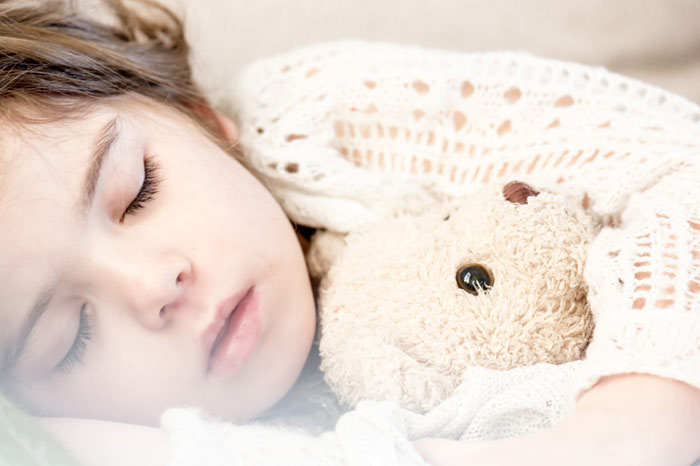Sleepwalking in Kids: Causes & Tips
By sleepwalking we mean a – usually nighttime – activity when a person starts to walk about or perform other actions without really waking up. They are sleeping deeply yet they are capable of moving – especially while the night is still young and they fell asleep but recently.
 Children are not exempt: sleepwalking can be pediatric, some children go to sleep, then get up and move around. This condition (sometimes referred to as somnambulism) is most active after the child turns four and before they reach the age of 8.
Children are not exempt: sleepwalking can be pediatric, some children go to sleep, then get up and move around. This condition (sometimes referred to as somnambulism) is most active after the child turns four and before they reach the age of 8.
Somnambulistic kids go to bed, and in an hour or so they get out of it still sleeping. For about 10-15 minutes they perform some activities which are usually quite harmless. As they grow up, they leave the habit behind. Yet, when sleepwalking, they might get hurt or injured, so it is wrong to rely on its seeming innocuousness and leave the issue unattended.
Although the name implies walking, the condition embraces quite a lot of various activities. They can be classified as:
- inoffensive, like assuming a seated position
- potentially risky, like leaving the house
- incongruous, like peeing whenever the desire caught them
Whatever you saw them doing during the sleepwalking phase, don’t think they retain the memory of their somnambulistic behavior.
Also, you can take measures ensuring the safety of your little sleepwalker while they are on the prowl.
Why does it occur?
Actually, sleepwalking is more children’s condition than grown-ups’. It could be handed down to the next generation, and if sleepwalking runs in your (or your partner’s) family, be ready your kid might emulate.
What can bring about the inclination to sleepwalk?
- insufficient sleep, going to sleep tired
- not having regular bed hours
- high temperature, illness
- taking certain medication
- laboring under stress
What can you expect from sleepwalking?
The most common thing for a little somnambulist is to get up and walk about without waking up, but that isn’t the only symptom by far. They can also:
- say something
- make awkward movements
- look fuddled, spaced out
- fail to respond if addressed
- remain in bed in a sitting position and gesture repeatedly, for instance rub their eyes, fumble with their night shirts
- fail to respond to attempts to bring them awake
Although they walk and function with their eyes open, don’t think they see anything, at least realistically. They can picture themselves in other places or parts of the house.
Sleepwalking can be accompanied by other symptoms or conditions, like:
- apnea, that is breathing pauses during sleep
- enuresis, that is wetting the bed
- scary dreams
In what ways can somnambulism be pernicious?
Regarded in general, sleepwalking is rather harmless – although the fact that children can’t very well understand what is happening may result in a potentially dangerous situation if they reach a steep staircase or start getting windows open.
As for the psychological side, somnambulism cannot be taken as a symptom of the kid’s emotional distress. If they don’t do anything which might lead to an injury, in the morning they won’t remember their perambulations, and no stress is likely to result.
What measures can be taken to ensure safety?
While there’s no reason to be overanxious, it is advisable to take certain precautions against your kid tripping, falling, walking into furniture, or stepping out of the house. The older the kid the more mishaps they can walk into.
What safety behaviors had better be adopted?
You shouldn’t wake the sleepwalker – they may get scared finding themselves in an unexpected place. The thing is to guide them to their bed.
If you have a freely wandering child, before you go to bed make sure the windows and doors are bolted properly. See if you need to install more locks or some special locks. If your young sleepwalker could go for a ride in his sleep, hide the keys away in a safe place.
Mind that bunk beds can make little sleepwalkers fall.
The kid’s room mustn’t contain items that can be dislodged and broken, or things with sharp edges.
Dangerous items should be stashed out of the way.
Any objects that can trip the child should also be moved out of the way; the child’s room must be cleaned of toys and things left lying on the floor.
Safety gates can be installed on top landings of the staircases.
When is it time to consult a doctor?
Apart from taking precautions, you can ignore sleepwalking instances until you observe the following symptoms:
- sleepwalking gets regular
- the kid feels sleepy in the afternoons
- they are prone to acting dangerously
The issue can be consigned to a doctor if you are worried that it occurs too often, sleepwalking is apt to take on an alarming edge, you feel that your kid has become too old and ought to have thrown off the condition a while ago (teenagers are rarely given to the habit).
In case sleepwalking leads to problems, experts can introduce a technique of scheduled awakening: after having established the time when your child is likely to sleepwalk, they are wakened a quarter of an hour before the expected occurrence, thereby altering the kid’s sleeping schedule and preventing them from somnambulistic habits.
What other pieces of advice can you get?
There are factors that can weaken sleepwalking propensity:
- As soon as your kid gets into bed, help them relax by playing special relaxation audio programs or slow music.
- Set up a sleeping schedule to be strictly observed, including daytime naps.
- Put the child to bed earlier, especially if they grow sleepy in the evenings.
- Since a heavy bladder can be linked to getting up and walking in sleep, don’t give your child many drinks in the evening and see they relieve themselves before bedtime.
- Don’t give them caffeine drinks late in the day.
- The child’s room should be cozy and quiet, providing for undisturbed sleep.
- When the child is sleeping or having a nap, avoid making unnecessary noise.
- When you come across your kid sleepwalking at night, don’t overreact. As gently as you can take him or her back to bed and make them comfortable.




